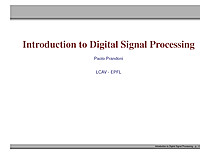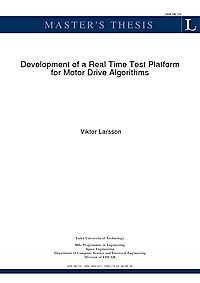
Development of a real time test platform for motor drive algorithms
In this thesis a real time test platform for a permanent magnet synchronous motor is developed. The implemented algorithm is Field Oriented Control (FOC) and it is implemented on a Texas Instruments TMS320F2808 Digital Signal Processor (DSP). The platform is developed in a rapid prototyping approach using Matlab/Simulink and the Real Time Workshop (RTW) packages.With this software the control algorithm and its interface to different DSP modules, such as A/D converter and PWM module, is constructed as a Simulink block scheme. The blocks used come from ordinary Simulink libraries and libraries provided by the RTW packages. From the Simulink block scheme Matlab can auto generate embedded C code adapted for different embedded targets, in this case the 2808 DSP.The developed real time test platform is also a Simulink model, though different from the algorithm model. When the start simulation command is given in the platform model a Graphical User Interface is loaded which lets the user specify motor parameters and certain algorithm parameters. Once the parameters are chosen RTW generates code from the algorithm model, loads it into the DSP and runs the generated program. From the platform model it is possible to set the reference speed of the motor in real time and monitor/log motor parameters such as actual speed and stator currents.
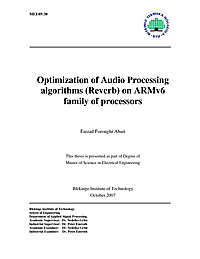
Optimization of Audio Processing algorithms (Reverb) on ARMv6 family of processors
Audio processing algorithms are increasingly used in cell phones and today’s customers are placing more demands on cell phones. Feature phones, once the advent of mobile phone technology, nowadays do more than just providing the user with MP3 play back or advanced audio effects. These features have become an integral part of medium as well as low-end phones. On the other hand, there is also an endeavor to include as improved quality as possible into products to compete in market and satisfy users’ needs. Tackling the above requirements has been partly satisfied by the advance in hardware design and manufacturing technology. However, as new hardware emerges into market the need for competence to write efficient software and exploit the new features thoroughly and effectively arises. Even though compilers are also keeping up with the new tide space for hand optimized code still exist. Wrapped in the above goal, an effort was made in this thesis to partly cover the competence requirement at Multimedia Section (part of Ericsson Mobile Platforms) to develope optimized code for new processors. Forging persistently ahead with new products, EMP has always incorporated the latest technology into its products among which ARMv6 family of processors has the main central processing role in a number of upcoming products. To fully exploit latest features provided by ARMv6, it was required to probe its new instruction set among which new media processing instructions are of outmost importance. In order to execute DSP-intensive algorithms (e.g. Audio Processing algorithms) efficiently, the implementation should be done in low-level code applying available instruction set. Meanwhile, ARMv6 comes with a number of new features in comparison with its predecessors. SIMD (Single Instruction Multiple Data) and VFP (Vector Floating Point) are the most prominent media processing improvements in ARMv6. Aligned with thesis goals and guidelines, Reverb algorithm which is among one of the most complicated audio features on a hand-held devices was probed. Consequently, its kernel parts were identified and implementation was done both in fixed-point and floating-point using the available resources on hardware. Besides execution time and amount of code memory for each part were measured and provided in tables and charts for comparison purposes. Conclusions were finally drawn based on developed code’s efficiency over ARM compiler’s as well as existing code already developed and tailored to ARMv5 processors. The main criteria for optimization was the execution time. Moreover, quantization effect due to limited precision fixed-point arithmetic was formulated and its effect on quality was elaborated. The outcomes, clearly indicate that hand optimization of kernel parts are superior to Compiler optimized alternative both from the point of code memory as well as execution time. The results also confirmed the presumption that hand optimized code using new instruction set can improve efficiency by an average 25%-50% depending on the algorithm structure and its interaction with other parts of audio effect. Despite its many draw backs, fixed-point implementation remains yet to be the dominant implementation for majority of DSP algorithms on low-power devices.
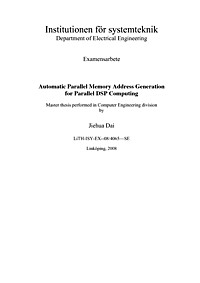
Automatic Parallel Memory Address Generation for Parallel DSP Computing
The concept of Parallel Vector (scratch pad) Memories (PVM) was introduced as one solution for Parallel Computing in DSP, which can provides parallel memory addressing efficiently with minimum latency. The parallel programming more efficient by using the parallel addressing generator for parallel vector memory (PVM) proposed in this thesis. However, without hiding complexities by cache, the cost of programming is high. To minimize the programming cost, automatic parallel memory address generation is needed to hide the complexities of memory access. This thesis investigates methods for implementing conflict-free vector addressing algorithms on a parallel hardware structure. In particular, match vector addressing requirements extracted from the behaviour model to a prepared parallel memory addressing template, in order to supply data in parallel from the main memory to the on-chip vector memory. According to the template and usage of the main and on-chip parallel vector memory, models for data pre-allocation and permutation in scratch pad memories of ASIP can be decided and configured. By exposing the parallel memory access of source code, the memory access flow graph (MFG) will be generated. Then MFG will be used combined with hardware information to match templates in the template library. When it is matched with one template, suited permutation equation will be gained, and the permutation table that include target addresses for data pre-allocation and permutation is created. Thus it is possible to automatically generate memory address for parallel memory accesses. A tool for achieving the goal mentioned above is created, Permutator, which is implemented in C++ combined with XML. Memory access coding template is selected, as a result that permutation formulas are specified. And then PVM address table could be generated to make the data pre-allocation, so that efficient parallel memory access is possible. The result shows that the memory access complexities is hiden by using Permutator, so that the programming cost is reduced.It works well in the context that each algorithm with its related hardware information is corresponding to a template case, so that extra memory cost is eliminated.
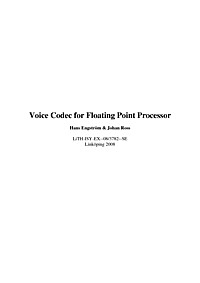
Voice Codec for Floating Point Processor
As part of an ongoing project at the department of electrical engineering, ISY, at Linköping University, a voice decoder using floating point formats has been the focus of this master thesis. Previous work has been done developing an mp3-decoder using the floating point formats. All is expected to be implemented on a single DSP.The ever present desire to make things smaller, more efficient and less power consuming are the main reasons for this master thesis regarding the use of a floating point format instead of the traditional integer format in a GSM codec. The idea with the low precision floating point format is to be able to reduce the size of the memory. This in turn reduces the size of the total chip area needed and also decreases the power consumption.One main question is if this can be done with the floating point format without losing too much sound quality of the speech. When using the integer format, one can represent every value in the range depending on how many bits are being used. When using a floating point format you can represent larger values using fewer bits compared to the integer format but you lose representation of some values and have to round the values off.From the tests that have been made with the decoder during this thesis, it has been found that the audible difference between the two formats is very small and can hardly be heard, if at all. The rounding seems to have very little effect on the quality of the sound and the implementation of the codec has succeeded in reproducing similar sound quality to the GSM standard decoder.
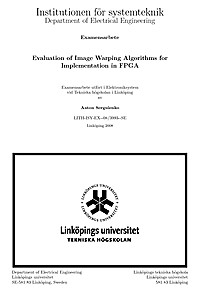
Evaluation of Image Warping Algorithms for Implementation in FPGA
The target of this master thesis is to evaluate the Image Warping technique and propose a possible design for an implementation in FPGA. The Image Warping is widely used in the image processing for image correction and rectification. A DSP is a usual choice for implantation of the image processing algorithms, but to decrease a cost of the target system it was proposed to use an FPGA for implementation. In this work a different Image Warping methods was evaluated in terms of performance, produced image quality, complexity and design size. Also, considering that it is not only Image Warping algorithm which will be implemented on the target system, it was important to estimate a possible memory bandwidth used by the proposed design. The evaluation was done by implemented a C-model of the proposed design with a finite datapath to simulate hardware implementation as close as possible.
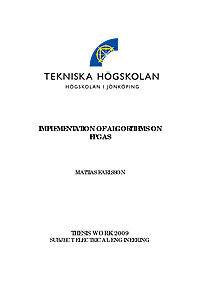
Implementation of Algorithms on FPGAs
This thesis describes how an algorithm is transferred from a digital signal processor to an embedded microprocessor in an FPGA using C to hardware program from Altera. Saab Avitronics develops the secondary high lift control system for the Boeing 787 aircraft. The high lift system consists of electric motors controlling the trailing edge wing flaps and the leading edge wing slats. The high lift motors manage to control the Boeing 787 aircraft with full power even if half of each motor’s stators are damaged. The motor is a PMDC brushless motor which is controlled by an advanced algorithm. The algorithm needs to be calculated by a fast special digital signal processor. In this thesis I have tested if the algorithm can be transferred to an FPGA and still manage the time and safety demands. This was done by transferring an already working algorithm from the digital signal processor to an FPGA. The idea was to put the algorithm in an embedded NIOS II microprocessor and speed up the bottlenecks with Altera’s C to hardware program. The study shows that the C-code needs to be optimized for C to hardware to manage the up speeding part, as the tests showed that the calculation time for the algorithm actually became longer with C to hardware. This thesis also shows that it is highly probable to use an FPGA equipped with Altera’s NIOS II safety critical microprocessor instead of a digital signal processor to control the electrical high lift motors in the Boeing 787 aircraft.
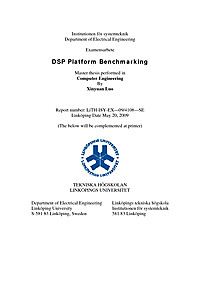
DSP Platform Benchmarking
Benchmarking of DSP kernel algorithms was conducted in the thesis on a DSP processor for teaching in the course TESA26 in the department of Electrical Engineering. It includes benchmarking on cycle count and memory usage. The goal of the thesis is to evaluate the quality of a single MAC DSP instruction set and provide suggestions for further improvement in instruction set architecture accordingly. The scope of the thesis is limited to benchmark the processor only based on assembly coding. The quality check of compiler is not included. The method of the benchmarking was proposed by BDTI, Berkeley Design Technology Incorporations, which is the general methodology used in world wide DSP industry. Proposals on assembly instruction set improvements include the enhancement of FFT and DCT. The cycle cost of the new FFT benchmark based on the proposal was XX% lower, showing that the proposal was right and qualified. Results also show that the proposal promotes the cycle cost score for matrix computing, especially matrix multiplication. The benchmark results were compared with general scores of single MAC DSP processors offered by BDTI.
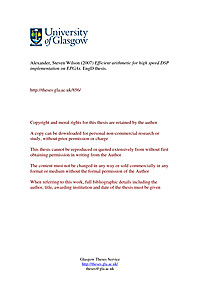
Efficient arithmetic for high speed DSP implementation on FPGAs
The author was sponsored by EnTegra Ltd, a company who develop hardware and software products and services for the real time implementation of DSP and RF systems. The field programmable gate array (FPGA) is being used increasingly in the field of DSP. This is due to the fact that the parallel computing power of such devices is ideal for today’s truly demanding DSP algorithms. Algorithms such as the QR-RLS update are computationally intensive and must be carried out at extremely high speeds (MHz). This means that the DSP processor is simply not an option. ASICs can be used but the expense of developing custom logic is prohibitive. The increased use of the FPGA in DSP means that there is a significant requirement for efficient arithmetic cores that utilises the resources on such devices. This thesis presents the research and development effort that was carried out to produce fixed point division and square root cores for use in a new Electronic Design Automation (EDA) tool for EnTegra, which is targeted at FPGA implementation of DSP systems. Further to this, a new technique for predicting the accuracy of CORDIC systems computing vector magnitudes and cosines/sines is presented. This work allows the most efficient CORDIC design for a specified level of accuracy to be found quickly and easily without the need to run lengthy simulations, as was the case before. The CORDIC algorithm is a technique using mainly shifts and additions to compute many arithmetic functions and is thus ideal for FPGA implementation.
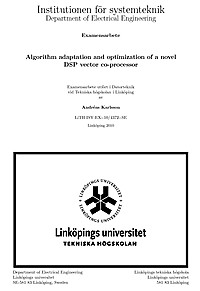
Algorithm Adaptation and Optimization of a Novel DSP Vector Co-processor
The Division of Computer Engineering at Linköping's university is currently researching the possibility to create a highly parallel DSP platform, that can keep up with the computational needs of upcoming standards for various applications, at low cost and low power consumption. The architecture is called ePUMA and it combines a general RISC DSP master processor with eight SIMD co-processors on a single chip. The master processor will act as the main processor for general tasks and execution control, while the co-processors will accelerate computing intensive and parallel DSP kernels.This thesis investigates the performance potential of the co-processors by implementing matrix algebra kernels for QR decomposition, LU decomposition, matrix determinant and matrix inverse, that run on a single co-processor. The kernels will then be evaluated to find possible problems with the co-processors' microarchitecture and suggest solutions to the problems that might exist. The evaluation shows that the performance potential is very good, but a few problems have been identified, that causes significant overhead in the kernels. Pipeline mismatches, that occurs due to different pipeline lengths for different instructions, causes pipeline hazards and the current solution to this, doesn't allow effective use of the pipeline. In some cases, the single port memories will cause bottlenecks, but the thesis suggests that the situation could be greatly improved by using buffered memory write-back. Also, the lack of register forwarding makes kernels with many data dependencies run unnecessarily slow.
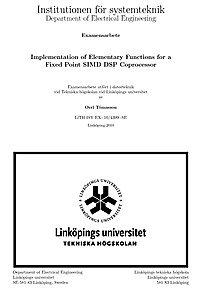
Implementation of Elementary Functions for a Fixed Point SIMD DSP Coprocessor
This thesis is about implementing the functions for reciprocal, square root, inverse square root and logarithms on a DSP platform. A multi-core DSP platform that consists of one master processor core and several SIMD coprocessor cores is currently being designed by a team at the Computer Engineering Department of Linköping University. The SIMD coprocessors’ arithmetic logic unit (ALU) has 16 multipliers to support vector multiplication instructions. By efficiently using the 16 multipliers, it is possible to evaluate polynomials very fast. The ALU does not have (hardware) support for floating point arithmetic, so the challenge is to get good precision by using fixed point arithmetic. Precise and fast solutions to implement the mathematical functions are found by converting the fixed point input to a soft floating point format before polynomial approximation, choosing a polynomial based on an error analysis of the polynomial approximation, and using Newton-Raphson or Goldschmidt iterations to improve the precision of the polynomial approximations. Finally, suggestions are made of changes and additions to the instruction set architecture, in order to make the implementations faster, by efficiently using the currently existing hardware.
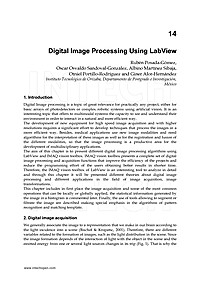
Digital Image Processing Using LabView
Digital Image processing is a topic of great relevance for practically any project, either for basic arrays of photodetectors or complex robotic systems using artificial vision. It is an interesting topic that offers to multimodal systems the capacity to see and understand their environment in order to interact in a natural and more efficient way. The development of new equipment for high speed image acquisition and with higher resolutions requires a significant effort to develop techniques that process the images in a more efficient way. Besides, medical applications use new image modalities and need algorithms for the interpretation of these images as well as for the registration and fusion of the different modalities, so that the image processing is a productive area for the development of multidisciplinary applications. The aim of this chapter is to present different digital image processing algorithms using LabView and IMAQ vision toolbox. IMAQ vision toolbox presents a complete set of digital image processing and acquisition functions that improve the efficiency of the projects and reduce the programming effort of the users obtaining better results in shorter time. Therefore, the IMAQ vision toolbox of LabView is an interesting tool to analyze in detail and through this chapter it will be presented different theories about digital image processing and different applications in the field of image acquisition, image transformations. This chapter includes in first place the image acquisition and some of the most common operations that can be locally or globally applied, the statistical information generated by the image in a histogram is commented later. Finally, the use of tools allowing to segment or filtrate the image are described making special emphasis in the algorithms of pattern recognition and matching template.
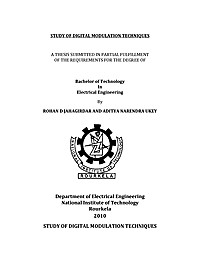
STUDY OF DIGITAL MODULATION TECHNIQUES
Modulation is the process of facilitating the transfer of information over a medium. Typically the objective of a digital communication system is to transport digital data between two or more nodes. In radio communications this is usually achieved by adjusting a physical characteristic of a sinusoidal carrier, either the frequency, phase, amplitude or a combination thereof . This is performed in real systems with a modulator at the transmitting end to impose the physical change to the carrier and a demodulator at the receiving end to detect the resultant modulation on reception. Hence, modulation can be objectively defined as the process of converting information so that it can be successfully sent through a medium. This thesis deals with the current digital modulation techniques used in industry. Also, the thesis examines the qualitative and quantitative criteria used in selection of one modulation technique over the other. All the experiments, and realted data collected were obtained using MATLAB and SIMULINK
A pole-zero placement technique for designing second-order IIR parametric equalizer filters
A new procedure is presented for designing second-order parametric equalizer filters. In contrast to the traditional approach, in which the design is based on a bilinear transform of an analog filter, the presented procedure allows for designing the filter directly in the digital domain. A rather intuitive technique known as pole-zero placement, is treated here in a quantitative way. It is shown that by making some meaningful approximations, a set of relatively simple design equations can be obtained. Design examples of both notch and resonance filters are included to illustrate the performance of the proposed method, and to compare with state-of-the-art solutions.
Adaptive distributed noise reduction for speech enhancement in wireless acoustic sensor networks
An adaptive distributed noise reduction algorithm for speech enhancement is considered, which operates in a wireless acoustic sensor network where each node collects multiple microphone signals. In previous work, it was shown theoretically that for a stationary scenario, the algorithm provides the same signal estimators as the centralized multi-channel Wiener filter, while significantly compressing the data that is transmitted between the nodes. Here, we present simulation results of a fully adaptive implementation of the algorithm, in a non-stationary acoustic scenario with a moving speaker and two babble noise sources. The algorithm is implemented using a weighted overlap-add technique to reduce the overall input-output delay. It is demonstrated that good results can be obtained by estimating the required signal statistics with a long-term forgetting factor without downdating, even though the signal statistics change along with the iterative filter updates. It is also demonstrated that simultaneous node updating provides a significantly smoother and faster tracking performance compared to sequential node updating.
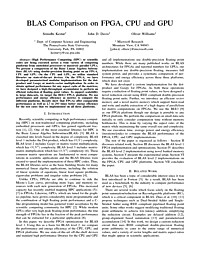
BLAS Comparison on FPGA, CPU and GPU
High Performance Computing (HPC) or scientific codes are being executed across a wide variety of computing platforms from embedded processors to massively parallel GPUs. We present a comparison of the Basic Linear Algebra Subroutines (BLAS) using double-precision floating point on an FPGA, CPU and GPU. On the CPU and GPU, we utilize standard libraries on state-of-the-art devices. On the FPGA, we have developed parameterized modular implementations for the dot product and Gaxpy or matrix-vector multiplication. In order to obtain optimal performance for any aspect ratio of the matrices, we have designed a high-throughput accumulator to perform an efficient reduction of floating point values. To support scalability to large data-sets, we target the BEE3 FPGA platform. We use performance and energy efficiency as metrics to compare the different platforms. Results show that FPGAs offer comparable performance as well as 2.7 to 293 times better energy efficiency for the test cases that we implemented on all three platforms.

Implementation of Elementary Functions for a Fixed Point SIMD DSP Coprocessor
This thesis is about implementing the functions for reciprocal, square root, inverse square root and logarithms on a DSP platform. A multi-core DSP platform that consists of one master processor core and several SIMD coprocessor cores is currently being designed by a team at the Computer Engineering Department of Linköping University. The SIMD coprocessors’ arithmetic logic unit (ALU) has 16 multipliers to support vector multiplication instructions. By efficiently using the 16 multipliers, it is possible to evaluate polynomials very fast. The ALU does not have (hardware) support for floating point arithmetic, so the challenge is to get good precision by using fixed point arithmetic. Precise and fast solutions to implement the mathematical functions are found by converting the fixed point input to a soft floating point format before polynomial approximation, choosing a polynomial based on an error analysis of the polynomial approximation, and using Newton-Raphson or Goldschmidt iterations to improve the precision of the polynomial approximations. Finally, suggestions are made of changes and additions to the instruction set architecture, in order to make the implementations faster, by efficiently using the currently existing hardware.
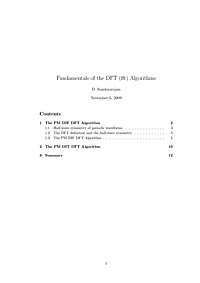
Fundamentals of the DFT (fft) Algorithms
In this article, a physical explanation of the fundamentals of the DFT (fft) algorithms is presented in terms of waveform decomposition. After reading the article and trying the examples, the reader is expected to gain a clear understanding of the basics of the mysterious DFT (fft) algorithms.
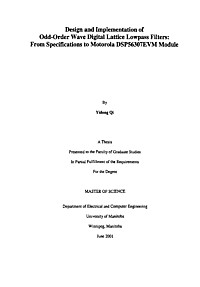
Design and implementation of odd-order wave digital lattice lowpass filters, from specifications to Motorol DSP56307EVM module
This thesis is dedicated to applying and developing explicit formulas for the design and implementation of odd-order lattice Lowpass wave digital filters (WDFs) on a Digital Signal Processor (DSP), such as a Motorola DSP56307EVM (Evaluation Module). The direct design method of Gazsi for filter types such as Butterworfh, Chebyshev, inverse Chebyshev, and Cauer (Elliptic) provides a straightforward method for calculating the coefficients without an extensive knowledge of digital signal processing. A program package to design and implement odd-order WDFs, including detailed procedures and examples, is presented in this thesis and includes not only the calculations of the coefficients, but also the simulation on a MATLAB platform and an implementation on a Motorola DSP56307EVM board. It is very quick, effective and convenient to obtain the coefficients when the user enters a few parameters according to the general specifications; to verify the characteristics of the designed filter; to simulate the filter on the MATLAB platform; to implement the filter on the DSP board; and to compare the results between the simulation and the implementation.
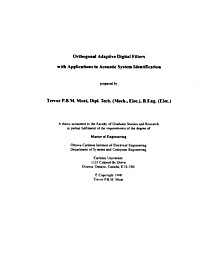
Orthogonal Adaptive Digital Filters with Applications to Acoustic System Identification
The Transform-Domain LMS Algorithm (Narayan, 1983) is studied in the context of an acoustic system identification problem. The power estimator in this two-stage digital filter is shown to affect the achievable rates and depths of convergence significantly. Preferred values for the two tracking parameters, $\beta$ and $\mu,$ are determined. Dynamic Step-size Initialization is proposed to improve early convergence by accelerating the rate at which true power measurements replace (arbitrary) initial values. Later, linear estimators are shown to be sub-optimal, particularly where the spectral distribution of the reference changes rapidly. A simple non-linear Peak Window Power Estimator which eliminates these problems is described. It will be shown to improve the tracking rates and misadjustment simultaneously. The benefits of these methods are demonstrated using FIR sequences representative of typical acoustic environments and using recordings from a commercial telephone set. The proposed structures surpass theexisting algorithms consistently under all circumstances tested.








